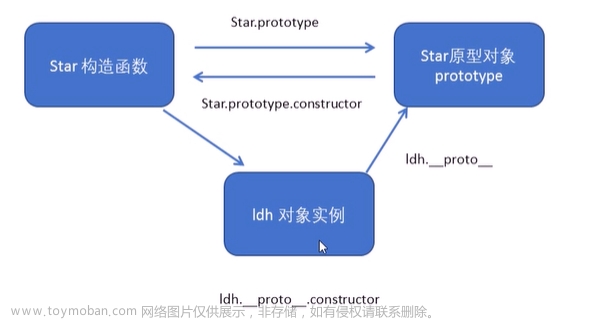1.原型链继承
实现原理:子类的原型指向父类实例。子类在自身实例上找不到属性和方法时去它父类实例(父类实例和实例的原型对象)上查找,从而实现对父类属性和方法的继承
缺点:
- 子类创建时不能传参(即没有实现super()的功能);
- 父类实例的修改会影响子类所有实例
function Parent(name){
this.name = "父级的name";
}
Parent.prototype.getName = function(){
console.log("getName:"+this.name);
}
function Child(){
}
// 子类原型指向父类的实例
Child.prototype = new Parent();
Child.prototype.constructor = Child;//这句话和原型链继承没有关系,只是根据原型链规则绑定constructor
// 测试
var child = new Child();
console.log(child.name);//父级的name
child.getName();//getName:父级的name
// 缺点:不能传参;父类实例改变子类所有实例也改变2.构造函数继承
实现原理:子类构造函数中执行父类的构造函数,并且为父类构造函数绑定子类的this,父类的构造函数把成员属性和方法都挂到子类的this上去,这样既能避免实例之间共享一个原型实例,又能向父类构造方法传参
缺点:无法继承父类原型上的属性和方法
// 构造函数继承
function Parent(name) {
this.name = name;
console.log("父类构造函数");
}
Parent.prototype.getName = function () {
console.log("getName:" + this.name);
}
function Child(name){
Parent.call(this, name);
}
var child = new Child("张三");
console.log(child);//Child {name: '张三'}
// 不能继承父类原型上的方法和属性
child.getName();//报错,child.getName is not a function3.组合式继承
实现原理:原型链继承+构造函数继承
缺点:父类构造函数会执行两次(Parent.call()和new Parent()),这不影响子类对父类的继承,但是每次创建子类实例时原型中都会有两份相同的属性和方法
// 组合式继承:原型链继承+构造函数继承
function Parent(name) {
this.name = name;
console.log("父类构造函数");
}
Parent.prototype.getName = function () {
console.log("getName:" + name);
}
function Child(name) {
Parent.call(this, this.name);
}
Child.prototype = new Parent();
Child.prototype.constructor = Child;
var child = new Child("张三");
console.log(child);//Child {name: '张三'}
child.getName();
4.寄生式组合继承
实现原理:父类构造函数会执行两次(Parent.call()和new Parent()),那么在原型链继承时就只继承父类的原型,就不会执行两次父类构造函数 Child.prototype = Parent.prototype;
缺点:操作子类原型对象,会影响到父类原型对象,例如给Child.prototype增加一个getName()方法,那么会导致Parent.prototype也增加或被覆盖一个getName()方法
// 寄生式组合继承:原型链继承(只继承父类原型)+构造函数继承
function Parent(name) {
this.name = name;
}
Parent.prototype.getName = function () {
console.log("getName:" + this.name);
}
function Child(name) {
Parent.call(this, name);
}
Child.prototype = Parent.prototype;
Child.prototype.constructor = Child;
var child = new Child("张三");
console.log(child);//Child {name: '张三'}
child.getName();
4.1解决寄生式组合继承的缺点(使用Object.create()进行继承)
如下,对Child.prototype.getName子类中原型上属性或方法进行修改时,父类也被修改
function Parent(name) {
this.name = name;
console.log("父类构造函数");
}
Parent.prototype.getName = function () {
console.log("父类getName");
}
function Child(name) {
Parent.call(this, name);
}
Child.prototype = Parent.prototype;
Child.prototype.constructor = Child;
Child.prototype.getName = function(){
console.log("子类getName");
}
var child = new Child("张三");
console.log(child);//Child {name: '张三'}
child.getName();
var parent = new Parent("李四");
parent.getName();
解决:加上Object.create()方法即可
// Child.prototype = Parent.prototype;
Child.prototype = Object.create(Parent.prototype); 
5.ES6的Class继承
实现原理:ES6新增,是ES5中构造函数+原型链继承组合继承,寄生组合式继承的结合
缺点:兼容性不好文章来源:https://www.toymoban.com/news/detail-724877.html
6.扩展——对象的几种创建方式
- 字面量创建
- var obj = new Object()创建
- 构造函数创建
- Object.create()创建
// 字面量创建
let obj1 = {
name: 'lmf1',
say() {
console.log("lmf1 say");
}
}
// new Object()创建
let obj2 = new Object({
name: 'lmf2',
say() {
console.log("lmf2 say");
}
});
// 构造函数创建
function Person(name) {
this.name = name;
}
let obj3 = new Person("lmf3");
Person.say = function () {
console.log("静态方法");
}
Person.prototype.say = function () {
console.log("lmf3 say");
}
// Object.create()创建
let obj4 = Object.create(obj3);
console.log(obj1, obj2, obj3, obj4); 文章来源地址https://www.toymoban.com/news/detail-724877.html
文章来源地址https://www.toymoban.com/news/detail-724877.html
到了这里,关于js继承的几种方式(原型链继承、构造函数继承、组合式继承、寄生组合式继承、ES6的Class类继承)的文章就介绍完了。如果您还想了解更多内容,请在右上角搜索TOY模板网以前的文章或继续浏览下面的相关文章,希望大家以后多多支持TOY模板网!








